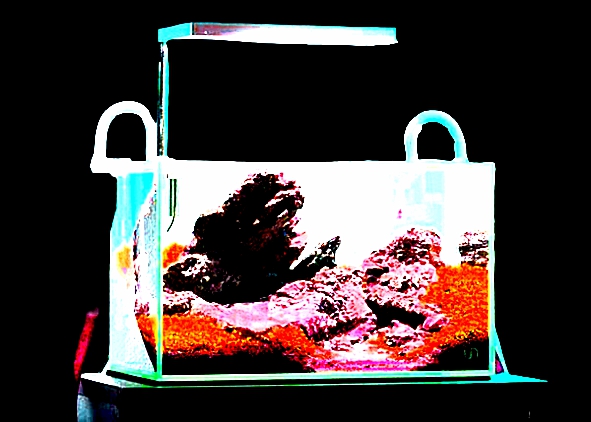I will explore five distinct styles of aquascaping, detailing the intricacies that make each one unique and captivating.
The Jungle Style of Aquascaping
The Jungle style, one of the most common approaches, is arguably the simplest to create. Its primary appeal lies in a design that mimics the untamed and wild appearance of a natural jungle.
There are no limits on the number of plant species, and the setup can accommodate a wide variety of fish.
However, tall, large-leafed plants like Echinodorus species are frequently used to fill the aquarium. A dense population of plants also helps maintain water clarity and control algae.
Depending on the desired level of wildness, the Jungle style requires less meticulous plant maintenance and hardscape arrangement compared to other styles.
Downsides of a Jungle Aquascape
The Jungle style does have some disadvantages. The significant plant growth can limit the open swimming space available for fish and other inhabitants.
The fish are not the only ones that may face challenges. Depending on the chosen flora, plants may compete for physical space and, more importantly, for light.
Dense foliage and larger plants can overshadow smaller ones, stunting their growth and potentially causing algae to develop on the struggling vegetation.
The Nature Aquarium Style
The Nature Aquarium is a style developed by Takashi Amano, one of the pioneers of modern aquascaping.
The goal of the Nature style is to create a harmonious aquascape that resembles a specific landscape or scene from the natural world.
One of my own creations, an aquascape I named Boreal “flew the chi,” falls into the Nature Aquarium category. Achieving a Nature Aquarium can be difficult because of the immense detail and complex work involved.
Wood, rocks, and plants must complement one another to produce the intended harmonious appearance. Careful consideration must be given to the shape of the hardscape, as well as the size, color, and growth rate of the plants.
The choice of fish is also crucial. The selected species should enhance the overall layout through their behavior, shape, color, and size.
The Iwagumi Style
Often considered the most challenging aquascaping style, Iwagumi is a Japanese design featuring a minimal selection of fish and low-growing plants, using an artful arrangement of stones to create a stark, minimalistic aesthetic.
Seiryu Stone is the most common type of rock used, but any variety of stone can be suitable. The term “Iwagumi” translates to “rock formation” in Japanese.
The Rock Formation Theory
The arrangement of rocks in an Iwagumi layout follows a specific theory. The structure is built around 4 main stones. The Oyaishi is the largest stone and serves as the primary focal point.
The Fukuishi, the second-largest stone, is placed to balance the Oyaishi. The Soeishi, the third-largest stone, provides additional support and emphasis to the Oyaishi.
Finally, the Suteishi is the fourth-largest stone, which complements the entire rock formation.
An Iwagumi formation is not restricted to only 4 rocks; many stones can be used. However, the presence of the 4 principal stone types is essential.
Ideal Fish for an Iwagumi Layout
For livestock, Iwagumi layouts typically feature small, schooling nano fish, regardless of the aquarium’s size.
The small stature of the fish contributes to the minimalist design and creates a sense of peace and scale through their fluid, schooling movements.
Maintenance Challenges of the Iwagumi Style
The Iwagumi layout is one of the most difficult styles to maintain.
Because of the limited selection of plants, it is very easy to inject too much carbon dioxide or over-fertilize the water column, creating a favorable environment for algae.
Furthermore, most plant species used in Iwagumi have slow to medium growth rates and cannot absorb nutrients quickly, which can also contribute to an over-fertilized water column.
Lighting presents another challenge, as the style is typically more open than other layouts.
Employing a lean fertilizing method and providing adequate light intensity will help combat potential algae problems.
The Biotope Aquascape
The goal of the Biotope style is to precisely replicate a specific natural habitat or ecosystem, like a particular lake or river.
Every element in the layout—from the substrate to the water parameters—is specifically chosen to represent the target environment.
For example, to recreate a river, an aquascaper would use a variety of long sticks and stones to mimic a natural stream bed. The plants and fish are also carefully selected to be authentic to the chosen ecosystem.
The style is not inherently difficult to build, but it requires extensive research to source the correct materials, livestock, and plants that accurately belong to the ecosystem being replicated.
The Dutch Style Aquascape
The Dutch style is a unique layout that focuses entirely on the beauty and arrangement of aquatic plants, containing no hardscape elements like rocks or wood.
The primary focus is to create a lush, underwater garden where different plant species are artfully arranged to complement one another.
It can be thought of as an underwater bouquet of flowers. Plants are grown in dense groups of the same species rather than being mixed, making stem plants highly recommended for a Dutch-style aquascape.
The Dutch style also features terraced layers or “Dutch streets,” which are rows created from a single plant species to create depth and contrast.
Red or other brightly colored plants are commonly used as focal points to create visual interest within the predominantly green landscape.
Regarding fish, appropriately sized schooling species are often chosen to add movement and highlight the beauty of the plants without distracting from them.
Guiding Principles of the Dutch Style
There are a few guiding principles for creating a Dutch aquascape. For example, plants with similar leaf structures or colors should not be placed next to each other to ensure contrast.
Following such principles is not mandatory, but doing so demonstrates extensive botanical knowledge, which is a key aspect of the style’s challenge.
Mastering the Dutch aquascape is difficult because it requires a comprehensive understanding of aquatic plants, including their growth habits, needs, and aesthetic qualities.
Conclusion
Aquascaping can be explored through five distinct styles, each shaped by its unique philosophy and care requirements.
I find the Jungle style to be the most natural and forgiving, with tall, broad-leafed plants growing freely to create a lush, wild environment.
The Nature Aquarium style, developed by Takashi Amano, is one I deeply admire for its focus on harmony. It combines carefully chosen wood, rocks, and plants to replicate natural landscapes with balance and precision.
Iwagumi is a minimalist approach that centers around the arrangement of four primary stones and low-growing plants.
I appreciate how this style uses small schooling fish to bring a sense of calm and scale. The Biotope style is a personal favorite when I want to replicate a specific ecosystem.
Every element, from the substrate to the fish and plants, must accurately reflect a real-world habitat such as a river or lake.
Finally, the Dutch style emphasizes dense, organized plant growth without the use of rocks or wood.
I enjoy arranging stem plants in layered rows, using contrasting shapes and colors to create depth and highlight the beauty of aquatic plant life.
Each style offers its own challenges and rewards, depending on the experience I want to create in my aquarium.

My name is Chibuzor Abraham Mba, and I’m the aquarist behind this website. I’ve spent years exploring the fascinating world of aquariums—especially small-scale tanks like nano and pico setups. Over time, I’ve made my fair share of mistakes, and through each one, I’ve learned valuable lessons.
